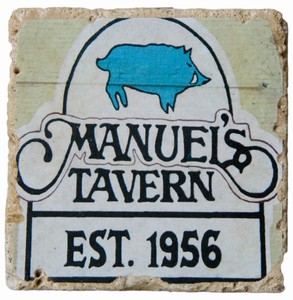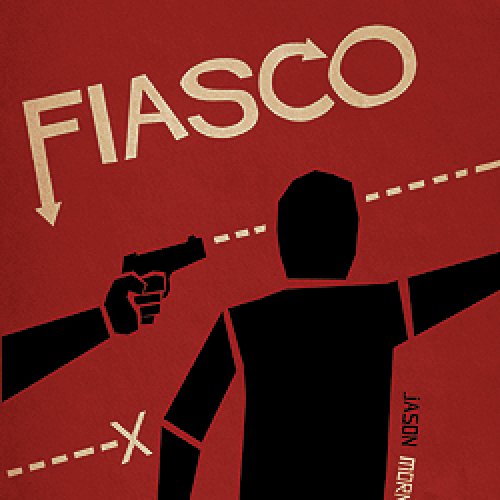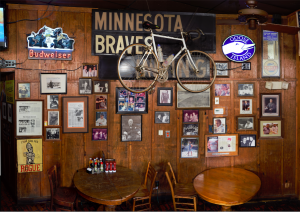Due: 9/22
For this assignment, each student will be taking part in the project to document and “unpack” Manuel’s Tavern. You’ll be choosing artifacts from the walls, researching more about what those objects depict or represent, and then composing texts that describe and play with the item. You’ll submit your entries to the folks at Unpacking Manuel’s and hopefully they will eventually be included in the site once it’s fully unveiled.
As you compose your Manuel’s text, I’ll ask that you be thinking about the process of such research and writing — what rhetorical situations does this sort of activity apply to? what sorts of audience(s) do you imagine for your text? how does writing your own descriptive text help you to think differently about similar texts you encounter in your own life, particularly in games but perhaps in other settings as well?
Some Context Unpacking Manuel’s
Last year, this project was described in the New York Times:
The artist and documentary filmmaker Ruth Dusseault calls the stuff that has found its way onto the walls of Manuel’s Tavern, a beloved Eisenhower-era dive bar here, an “organic archive” and a “60-year installation piece.”
[…]
Ms. Dusseault, a lecturer in the communications department at Georgia State University, is convinced that these items tell a rich and complex story of Atlanta. In an ambitious and slightly weird act of scholarship, she and a group of local academics have begun digitally documenting all of the curios and ephemera for an online research project they have titled “Unpacking Manuel’s Tavern.”
Ms. Dusseault likened the idea of examining the junk on the walls of a bar to the work of archaeologists. “They’ll go to a site, and they have a fascination with garbage,” she said, “because it can tell them so much about the civilization they’re studying.”
You can check these out to get a sense of where this is headed:
Assignment Details
You will each choose one object from the Minnesota Braves wall. I’ll loaded a spreadsheet in Google Drive that lists objects on that wall with some very basic information about each of them and you’ll each claim one item.
You will research that item and then write an entry of something like 500 to 1000 words. You’ll publish the entry as a set of pages (not blog posts, but pages) on your own site, with images, audio, and any other media as appropriate. You’ll also publish a piece of reflective writing in which you analyze your own process and learning as one of those pages. When you’ve finished your draft, you’ll write a blog post on your own site, linking to the splash page (introductory page) of your piece, and provided a bit of additional reflection on your work. When your post syndicates to the class site, that’s when your assignment is “turned in” to me.
I’ll expect each of you to read each other’s work and to comment on and to discuss with each other the work. There will be opportunities for review and revision, both formal and informal, before I officially grade your final draft.
Assignment Steps
Research
Once you’ve chosen an object from the wall and signed up on the spreadsheet, zoom in as close as you can on the high resolution gigapan of the wall and grab a good screenshot of your object.
Based on your observation of the item you’ve chosen and the information provided in the spreadsheet, research that object and try to ascertain as much information as you can about the significance of the object and what it represents. Take notes for yourself of not only the results of your research but of the steps you go through and of your own thinking about the process.
As part of your research, make sure to perform a reverse image search using your screenshot to find other similar objects. The reverse image search will probably be most fruitful with advertisements but definitely perform the search with your object and pay attention to any interesting comparisons you get back.
Writing
Publish a page to your class site with a 500 to 1000 word entry on the object that you have analyzed and researched. This write up should include a fairly detailed description of the item itself as well as a discussion of the relevant details you have gleaned during your analysis. A student at Georgia State has produced an excellent example in her blog entry on object #21, the Dekalb Seed Company flying ear corn sign.
Your page should include at least the good screenshot you took from the wall. You might also include other images that you turned up during your analysis (make certain you provide captions for any images, with attribution information and links to the images).
You should also publish a second page, as a subpage underneath the one described above, in which you explain your research and thinking process as you analyzed the source. List the sites you went to as your researched your object and what you found useful or difficult along the way. How did you determine what sources were relevant in your search?
(Note that in class, I had raised the possibility that you might be allowed to write something fictional in your entry, but for now at least, stick to a strictly nonfiction account of the object.)
Once those two pages are published, make certain they show up in your menu and are accessible. Then publish a blog post, which should include a link to this assignment page and a link to the main page describing your object. That blog post should also include a paragraph which serves as preview of your discussion of the object — think of it as a brief teaser that a reader might see and be interested by, and thus follow your link and read the essay you’ve written. Make certain your blog post includes an image too (and image credit) too!
Next Steps
Once you’ve completed the first drafts of this work, there will be additional steps for revision and for building on these entries as a class, but let’s discuss those once you’ve made some progress on the drafts first.
Works Cited
Fausset, Richard. “Digital Dig Unpacks Atlanta Dive Bar Rich in History.” The New York Times 9 Nov. 2015. NYTimes.com. Web. 10 Nov. 2015.










